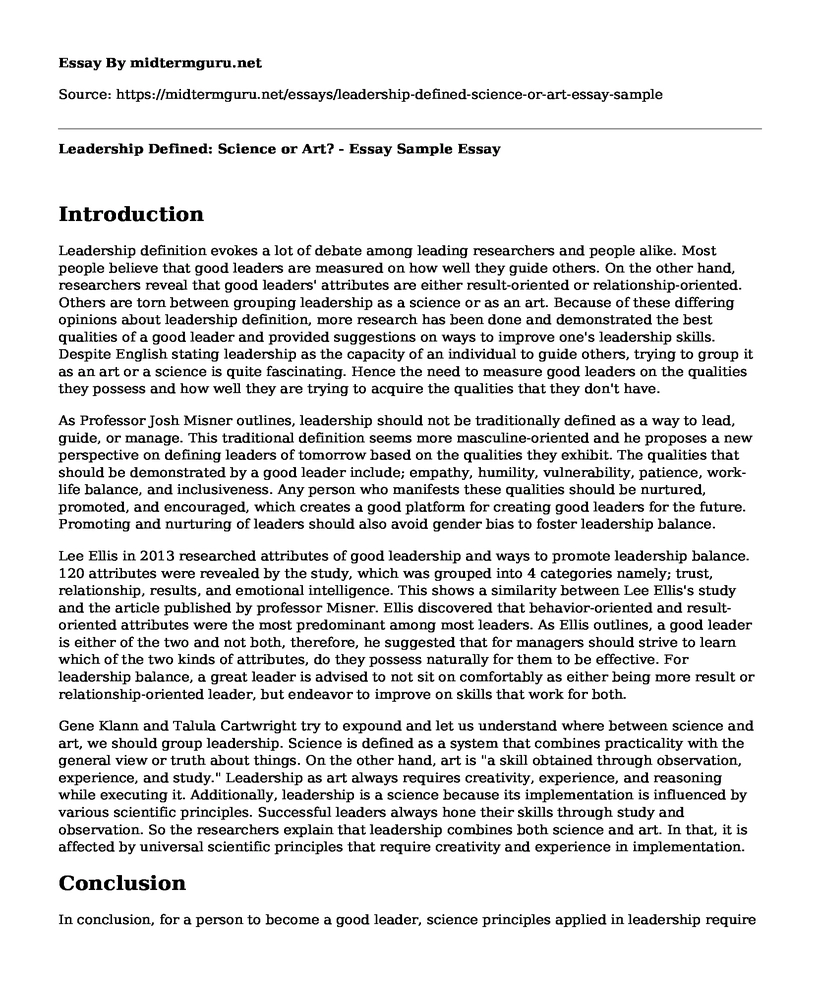Introduction
Leadership definition evokes a lot of debate among leading researchers and people alike. Most people believe that good leaders are measured on how well they guide others. On the other hand, researchers reveal that good leaders' attributes are either result-oriented or relationship-oriented. Others are torn between grouping leadership as a science or as an art. Because of these differing opinions about leadership definition, more research has been done and demonstrated the best qualities of a good leader and provided suggestions on ways to improve one's leadership skills. Despite English stating leadership as the capacity of an individual to guide others, trying to group it as an art or a science is quite fascinating. Hence the need to measure good leaders on the qualities they possess and how well they are trying to acquire the qualities that they don't have.
As Professor Josh Misner outlines, leadership should not be traditionally defined as a way to lead, guide, or manage. This traditional definition seems more masculine-oriented and he proposes a new perspective on defining leaders of tomorrow based on the qualities they exhibit. The qualities that should be demonstrated by a good leader include; empathy, humility, vulnerability, patience, work-life balance, and inclusiveness. Any person who manifests these qualities should be nurtured, promoted, and encouraged, which creates a good platform for creating good leaders for the future. Promoting and nurturing of leaders should also avoid gender bias to foster leadership balance.
Lee Ellis in 2013 researched attributes of good leadership and ways to promote leadership balance. 120 attributes were revealed by the study, which was grouped into 4 categories namely; trust, relationship, results, and emotional intelligence. This shows a similarity between Lee Ellis's study and the article published by professor Misner. Ellis discovered that behavior-oriented and result-oriented attributes were the most predominant among most leaders. As Ellis outlines, a good leader is either of the two and not both, therefore, he suggested that for managers should strive to learn which of the two kinds of attributes, do they possess naturally for them to be effective. For leadership balance, a great leader is advised to not sit on comfortably as either being more result or relationship-oriented leader, but endeavor to improve on skills that work for both.
Gene Klann and Talula Cartwright try to expound and let us understand where between science and art, we should group leadership. Science is defined as a system that combines practicality with the general view or truth about things. On the other hand, art is "a skill obtained through observation, experience, and study." Leadership as art always requires creativity, experience, and reasoning while executing it. Additionally, leadership is a science because its implementation is influenced by various scientific principles. Successful leaders always hone their skills through study and observation. So the researchers explain that leadership combines both science and art. In that, it is affected by universal scientific principles that require creativity and experience in implementation.
Conclusion
In conclusion, for a person to become a good leader, science principles applied in leadership require art or creativity, reasoning, and experience. Good leadership attributes like empathy, inclusivity, humility, vulnerability, and patience should be promoted among all people irrespective of gender. Moreover, leaders possessing these qualities should try to acquire those they don't have to promote leadership balance and foster their success.
References
Klann, G. (2003). Crisis Leadership: Using Military Lessons, Organizational Experiences, and the Power of Influence to Lessen the Impact of Chaos on the People You Lead (4th ed.). Charlotte, NC: Center for Creative Leadership.
Leadership, C. F., Cartwright, T., & Baldwin, D. (2011). Communicating Your Vision (1st ed.). Hoboken, NJ: John Wiley & Sons.
Lee, E. (2013). Understanding your leadership balance. Journal for Quality and Participation.
Misner, J. (2016, May 10). A New Definition Of Leadership. Retrieved October 9, 2019, from https://www.huffpost.com/entry/a-new-definition-of-leadership_b_4983043
Cite this page
Leadership Defined: Science or Art? - Essay Sample. (2023, Feb 21). Retrieved from https://midtermguru.com/essays/leadership-defined-science-or-art-essay-sample
If you are the original author of this essay and no longer wish to have it published on the midtermguru.com website, please click below to request its removal:
- Expert Power Leadership - Essay Example
- Communicative Dimension of Donald Trumps Leadership Style - Essay Sample
- Can an Authoritarian Leadership Style Be Appropriate in American Companies Currently? - Essay Sample
- The Business Strategies of the United Fruit Company - Paper Example
- Essay Sample on Applying an Ethical Decision-Making Model
- Elements of Thought: Keys to Successful Critical Decision-Making - Essay Sample
- Organizational Behavior: Key to Corporate Advantage - Essay Sample







